Community metrics from A to Z: a glossary of community KPIs (and how to move them)
Learn which community metrics matter most and how to improve your performance.
Community isn’t just a business differentiator—it’s a growth engine.
It powers product education and inspires product adoption. It fuels word-of-mouth marketing and builds brand affinity. It generates new opportunities and speeds up sales cycles.
But only if you can prove it.
As many community and developer relations practitioners can attest to, it’s not always easy to know what to measure or how. We see community professionals posting about it on LinkedIn (and talking about it in our Uncommon Slack community) all the time.
So we’ve put together this glossary to help you understand the most common metrics you can use to measure the health of your community and demonstrate return on investment. Even better, we’ll share tips for how to get your most important community KPIs moving up and to the right.
We know these numbers are important—that’s why we built our product to help track them. We also know there are plenty more out there, so we want to give everyone a chance to add their two cents.
Consider this glossary a living document built by, with, and for community leaders.
Keep reading to learn:
- What community metrics you should be tracking
- How to measure different community metrics
- Which strategies will get your community metrics moving in the right direction
Active members
What it is
Active members are the beating heart of your community. They’re the people who drive conversations, answer questions, and generally keep your community feeling lively. The more your members engage in high-quality interactions, the more your community is trending in the right direction.
How to measure it
You have to decide what “active” means to you. Posts? Replies? Shares? At Common Room, we define active members as individuals who engage in meaningful activities—such as posting in Slack or attending an event—within your community during a set time period. Members who don’t engage in any activities during this time period are considered inactive (time to set up a re-engagement workflow!).
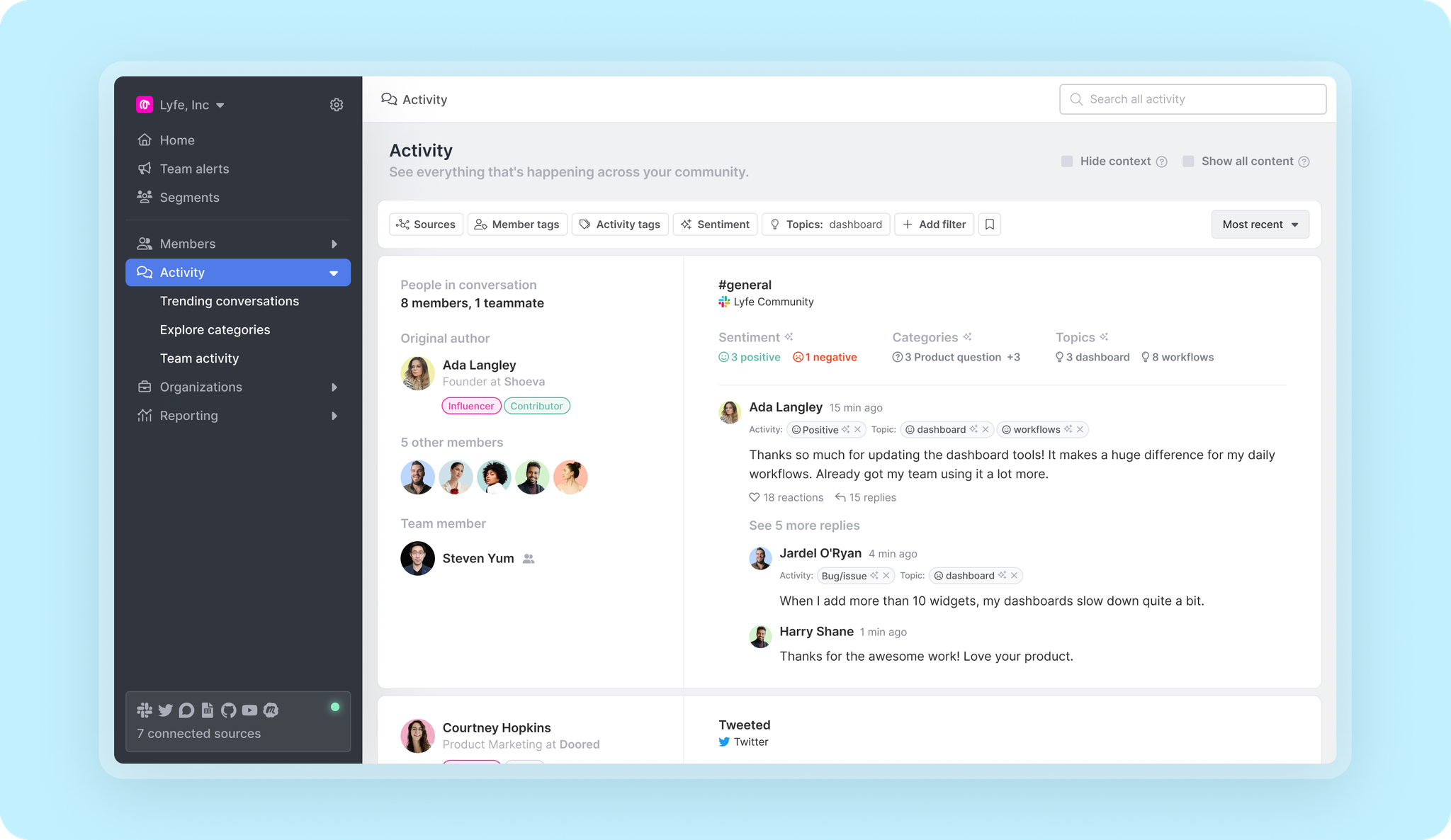
How to improve it
It’s important to inspire activity right from the get-go. Encourage new community members to introduce themselves and join in on the conversation. Regularly cultivate engagement via discussion topics, content, and good old-fashioned banter. And make sure you recognize and reward your most active members—this will keep them contributing and inspire others to follow suit (these individuals may also be great candidates for a champions program).
Activity by source
What it is
Community isn’t just one thing—it’s everywhere your customers are. And activity by source tells you where that is. It’s imperative to understand which channels your community members are engaging on, whether it’s owned channels (such as Slack and Discord) or unowned channels (such as Reddit and LinkedIn).
How to measure it
Identify all the digital watering holes where your community members hang out and get a centralized view into their activity across channels. Sound complicated? This is where a purpose-built tool like Common Room—which integrates with dozens of popular channels and allows you to report on activity by source—comes in. Otherwise you’re looking at a lot of platform-switching and spreadsheet-building.
How to improve it
This metric is less about “improving” and more about “understanding.” That is, understanding which channels drive the most community activity. This will help you determine where to allocate your resources and how you should customize your approach to community management. You can prioritize your members’ preferred channels and focus on growing and engaging your community where it likes to spend its time.
Champions
What it is
Champions are advocates both inside and outside your community. They help educate and empower other community members and spread the word about your product. Finding, supporting, and building relationships with these community ambassadors should be a top priority.
How to measure it
Determining exactly what makes someone a champion (or which criteria they should meet to join an official champions program) will differ from community to community. That said, Common Room makes it easier with segments, member tags, and impact points. These features help you track and engage the individuals who have the most impact on your community.
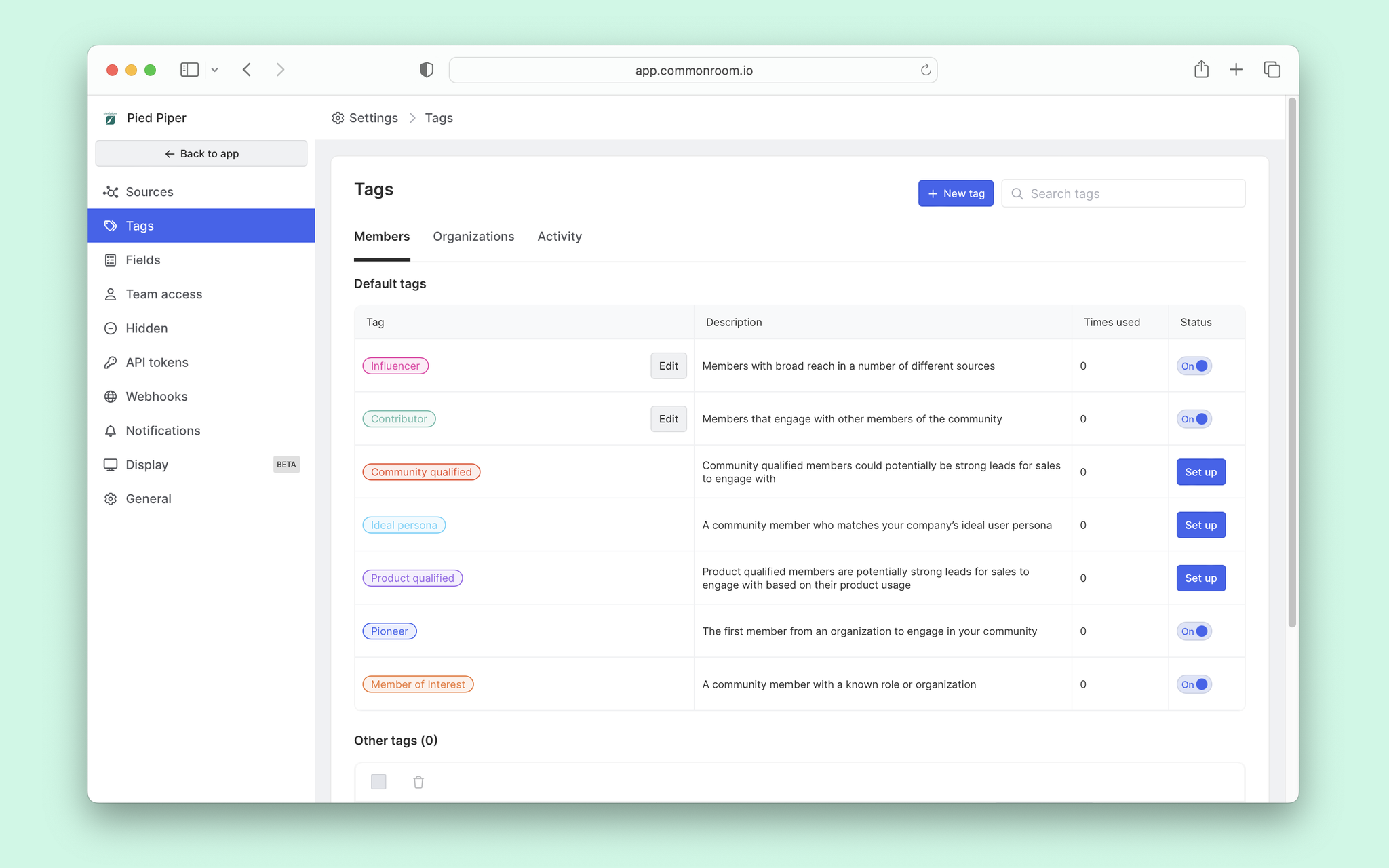
How to improve it
If you want people to act as champions, you need to give them a reason to do so. That starts with building a product people love. But you can go a step further by creating a mutually beneficial champions program. Check out this blog post to see how we built ours.
Churn rate
What it is
Communities are powered by people. If active members leave or become inactive (aka churn), it can drag down the value of your community—both for other members and your organization. While churn isn’t always bad—not everyone will be the right fit for your community—your goal should be to give active members who engage in meaningful activities a reason to stick around.
How to measure it
Divide the number of members who have left or gone dark in your community within a given time period by the total number of members during that same time period. That’s your churn rate.
How to improve it
It’s normal for community activity to fluctuate over time. Some members may join your community to get an answer to a specific question then leave. Some members who have gone dark may show back up down the line. But it’s worth reaching out to inactive members to get a sense of how they’re feeling (surveys are great for this). You should also take a look at your data to see if you can spot any commonalities among churned members. For example, if many members churn shortly after joining your community, it may be time to update your onboarding process.
Community-qualified leads
What it is
Community members sometimes make the best sales opportunities. After all, a lot of people join communities to try before they buy. Oftentimes these individuals appear in your community before they make their way to your CRM. Community-qualified leads (CQL) help you find them.
How to measure it
Set up custom criteria in Common Room to automatically tag community members as CQLs. You can filter members by industry, annual revenue, type of community activity, and more. Then, depending on how you partner with your go-to-market colleagues, you can push this information to your customer relationship management system for marketing and sales teams to review.
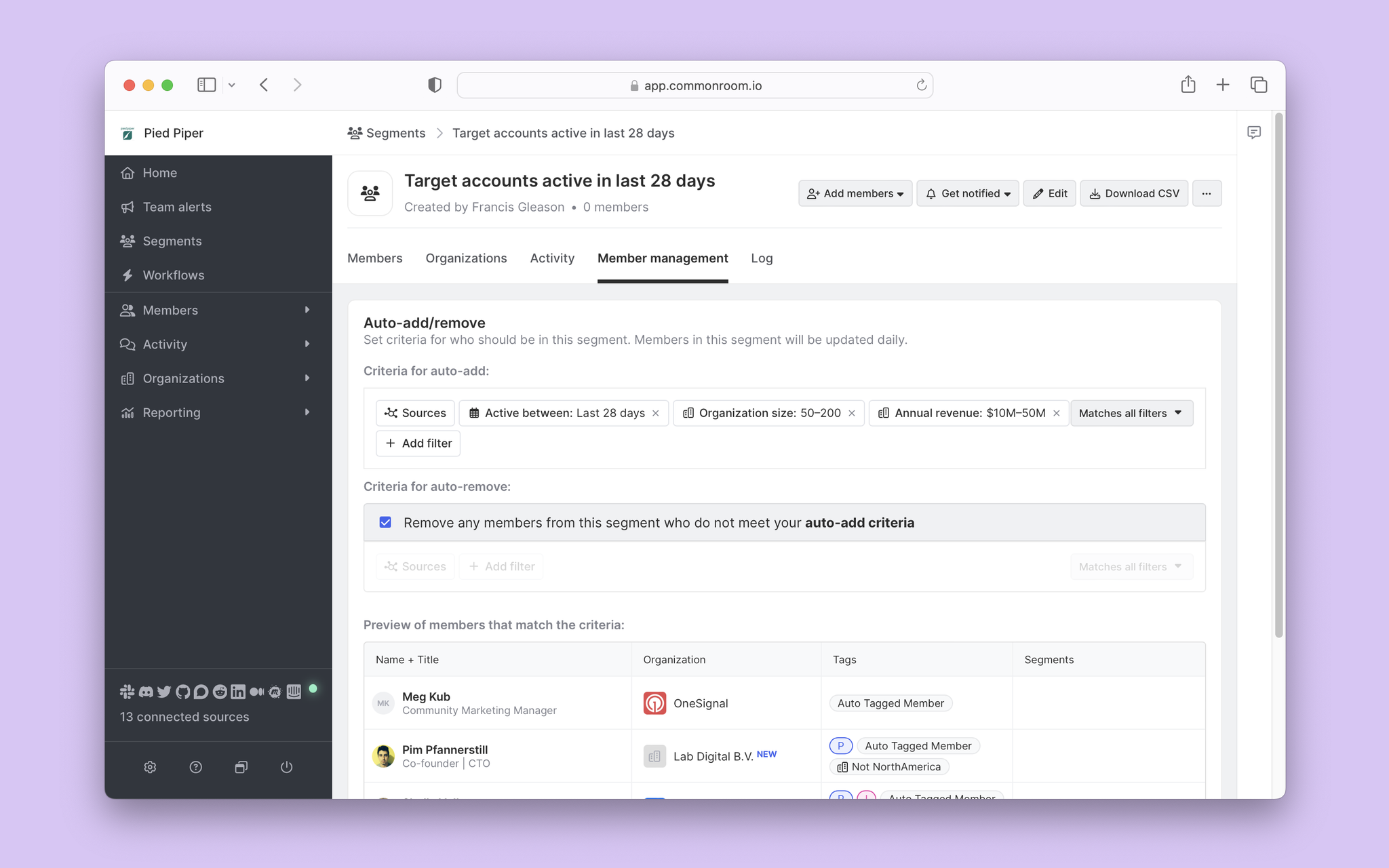
How to improve it
Quality is more important than quantity when it comes to leads. Work with your GTM colleagues to understand which criteria align with the people who are most likely to find value in your product and use those as filters to automatically spotlight high-fit and high-intent community members.
Deal time to close
What it is
Deal time to close will tell you what kind of impact your community is having on sales efficiency. Our research showed that 72% of community-led deals close within 90 days while only 42% of marketing- and sales-led deals can say the same. This metric helps you prove it.
How to measure it
Calculate the average number of days it takes for a deal to close across all deal types. Next, subtract the average number of days it takes community-qualified deals (see above) to close. You can break this out into two metrics: deals that were generally community-engaged as well as deals that were spotted in your community before your CRM. Divide this number by the average number of days it takes a deal to close across all deals and multiply it by 100.
How to improve it
Helpful communities accelerate sales cycles. They answer questions, highlight use cases, and generally make buyers feel more confident in a product and the team behind it. You can cultivate this by being responsive to community members (more on that below), sharing educational content, and connecting new members to power users in their industry.
Impact
What it is
“Impact” can mean lots of things. In this case, we’re talking about the effect a member has on your community by way of high-quality engagement. When you understand who’s having the most impact on your community, it becomes much easier to acknowledge and applaud your VIPs (as well as inform your champions program recruitment).
How to measure it
At Common Room, we measure impact using impact points. Points are associated with different activities that can be weighted based on their significance to your community, such as posts, replies, reactions, and more. If you have a different way of measuring impact, you can filter for source-specific activity in Common Room and create segments based on it. You can then set up a workflow to automatically add members to or remove them from segments based on their community activities (as well as use segments to quickly engage and report on specific community cohorts).
How to improve it
Similar to activity by source (see above), this is a metric where getting visibility into it is the primary benefit. That said, if you want to encourage others to participate in impactful activities more frequently, you need to determine which behaviors are most important to your goals and find ways to encourage them. Some organizations assign community members user scores that go up or down based on their activities, which helps to gamify community engagement.
Membership
What it is
Membership can be sliced and diced in multiple ways. There’s total membership, which tells you how your community is growing across all channels. Then there’s membership for specific channels, membership for certain geographic regions, membership among individuals who fit your ideal customer profile (ICP), and so on. You likely want all these numbers to go up, but certain types of community members are bound to be a higher priority.
How to measure it
Since communities can thrive across multiple channels at once, it’s helpful to use tools like Common Room that bring all membership data together in one place and let you analyze it across different time periods. The alternative is a lot of manual reporting across siloed platforms.
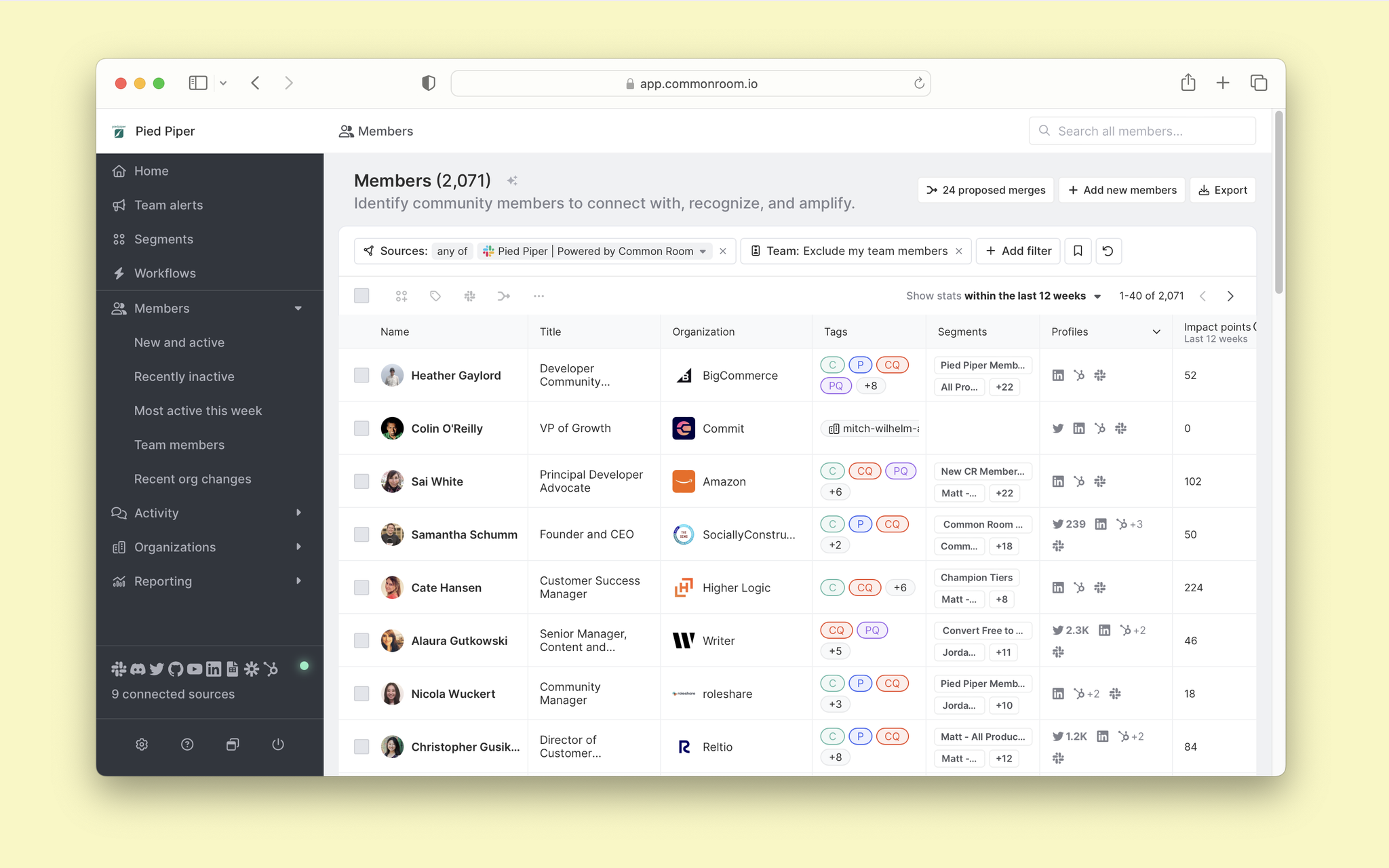
How to improve it
Community growth depends on a number of factors, but it all starts with a strong foundation. Understand who you’re building your community for, create a space that caters to those members’ wants and needs, and keep a close eye on growth metrics to spot opportunities for improvement.
Organization membership
What it is
When it's time to approach your community work with an eye toward business impact (now's a good time!), understanding community growth among members who work at target accounts is very helpful. Organization membership tells you where your community members are employed so you can keep an eye on the people who match your ICP.
How to measure it
Knowing exactly who your community members are and where they work is easier said than done. Some channels are anonymous by default. That’s where a tool like Common Room—which resolves member identities and creates detailed member profiles—comes into play. You can even use Common Room to get notified when community members switch jobs.
How to improve it
Every organization will have an employee who takes the first step of joining your community. We call these individuals “pioneers” (and assign them that tag within our product). In addition to making sure your community is a welcoming and helpful place for the organizations you want to attract, work to nurture pioneers so they’re more inclined to invite their colleagues.
Retention rate
What it is
Community member retention rate is closely linked to churn rate (see above). But in this case, you’re tracking how many members stay active in your community over time. The higher your retention rate, the higher the likelihood that people are finding value in your community.
How to measure it
Take the number of active community members you have at the end of a certain time period, subtract all the new members you gained during that same time period, and divide it by the number of members you had at the beginning of the time period.
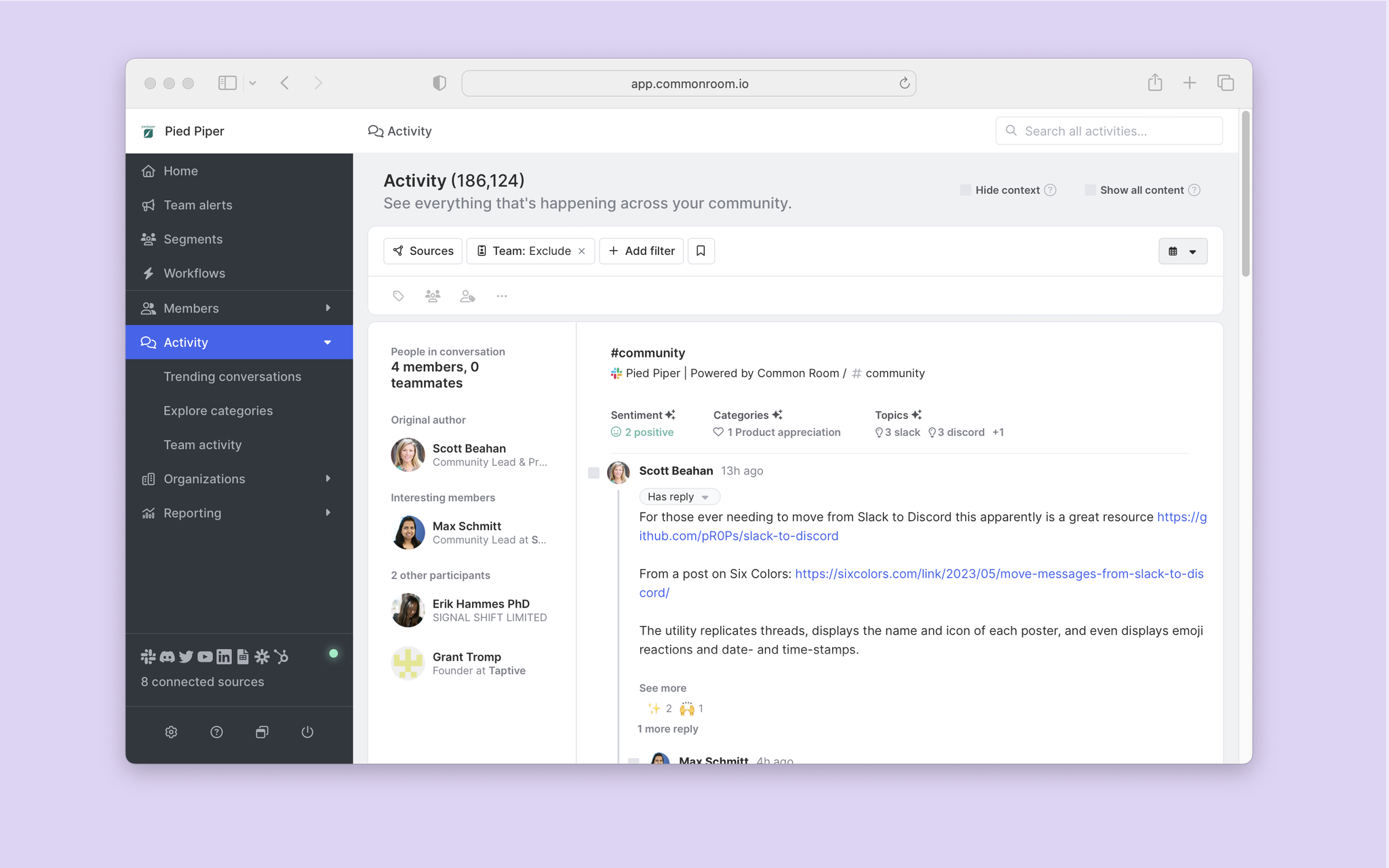
How to improve it
This is another situation where going straight to the source is the best policy. Even if you have a high retention rate, it’s no guarantee of long-term community growth. Reach out to both active and inactive community members to find out what makes them tick. Get a sense of what they like (and don’t like) about your community. Ask them what they’d like to see more of and deliver on what makes sense for the community at large.
Responses
What it is
Responses is the number of posts a community member has replied to from others in your community. Responding to posts from other community members shows a person’s willingness to engage, answer questions, and drive discussions (and could be a good way to find potential champions).
How to measure it
It’s possible to use unique identifiers within some platforms, such as thread_ts in Slack, to track all messages from an individual. If that’s too time-consuming—or you want to track messages across channels where unique identifiers aren’t readily available—you can use Common Room to filter community members by their number of non-self replies and comments.
How to improve it
Recognizing and rewarding community members for replying to each other is a great way to inspire more responses. Acknowledge and celebrate your most responsive members, either through public appreciation posts or private messages thanking them for their contributions (you can also use automated workflows in Common Room to bulk message members who meet a specific response threshold and automatically thank them).
Responsiveness
What it is
Responsiveness is all about how frequently your community members receive replies. As you can probably guess, the more often they get answers to their burning questions, the more satisfied they’ll be.
How to measure it
There are two things to measure when you’re looking at community responsiveness: how often someone gets a reply and who it comes from. Common Room shows you which posts do (and don’t) have replies, as well as whether your internal team members were involved. It’s a lot easier (and more customer-centric) than crawling through comments across channels.
How to improve it
Automated alerts (like the ones we provide) are a great way to stay on top of any community activity that requires a timely response. And while your community members aren’t a replacement for your internal teams, it’s a sign of a healthy community when members respond to each other. Encourage your champions and other community members to lend each other a helping hand (and keep an eye on your reporting to see the results).
Sentiment
What it is
Activity tells you what people are saying and doing. Sentiment tells you how they feel about it. You want people to post, comment, and share—but you also want it to be positive. Sure, product complaints can help you fix bugs, but it’s important to keep an eye on community sentiment to make sure your customers (and potential customers) are generally happy.
How to measure it
You can use surveys and polls to take a community’s temperature, but it’s difficult to do quickly and at scale. That’s why Common Room uses machine learning to automatically analyze community activity for sentiment and tag it as positive or negative.

How to improve it
Creating a community code of conduct is a great way to set the tone of your community and make sure people are respectful and inclusive. You can also make a special effort to foster a positive atmosphere, such as by celebrating wins and giving community members shout-outs. Just remember that negative sentiment isn’t bad in and of itself. Tracking negative sentiment can help you stay alerted to product issues, customer questions, and other business-related concerns you want to know about.
Time to response
What it is
Responsiveness (see above) is only part of the picture. How quickly community members receive a response to their pressing queries is just as important. Time to response will tell you how fast your team and wider community are getting back to members (you can find some helpful benchmarks here).
How to measure it
It’s best to leave your stopwatch at home. Unless you’re able to tie your community members to response time in your customer service platform, you’ll want a tool like Common Room that shows you median response time and how quickly (if at all) your team members got involved.
How to improve it
It’s the same game plan as responsiveness in general: Set up automated alerts to stay apprised of any community activity that requires a response, encourage your community at large to respond to each other when possible (be sure to reward them when they do), and pay close attention to response times to keep your internal teams on the ball.
Communities don’t stand still—they evolve. So do the metrics we use to measure them.
While one metric may be important on its own, it's often the case that metrics tell us most when we look at them in relation to one another. How many active members you have will answer one question, but analyzing that alongside retention rate, responsiveness, and sentiment will reveal a lot more about the health and trajectory of your community as a whole.
We’ll update this glossary over time to account for new ways to measure community health and prove ROI (you can add your suggestions here).
Got a metric you think we should build into Common Room? Get in touch!
Measure community health and prove ROI with Common Room
Ready to see how Common Room helps you trade manual measurement for automated insights?
We think you'd like these
Pricing for everyone: introducing simplified pricing for every go-to-market team
Apr 23rd, 2024·4min readSee how Common Room's new pricing helps every go-to-market team—from small startups to large enterprises—tap into the power of customer...Better together: announcing the Common Room Signal Partners Program
Apr 16th, 2024·11min readSee how Common Room's Signal Partners Program—kicking off today with 16 signal providers—helps you go beyond the status quo and run GTM intelligently.Power your GTM strategies with viral content monitoring
Mar 4th, 2024·3min readCheck out how Common Room's viral content monitoring can help go-to-market teams stay a step ahead of hot trends and topics in their industries.Put your GTM plays on autopilot with intelligent automations
Feb 26th, 2024·6min readCheck out how Common Room's new and improved workflow automations can help every go-to-market team execute on winning plays at scale.How to sell your sales team (and other folks) on community using Common Room
Nov 7th, 2023·10min readLearn how you can use Common Room to prove the power of community to every team in your organization.
